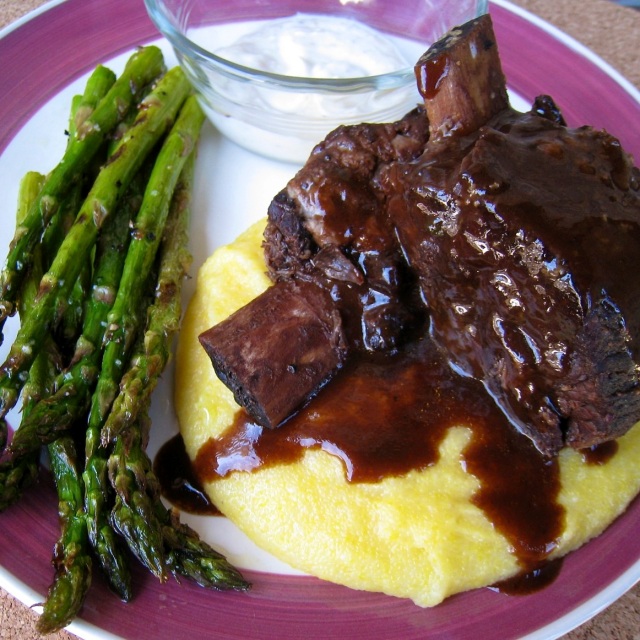* * *
Written almost 1 year ago, this is another “source-less” recipe, for I’ve long since lost those links. I do recall that the original protein was chicken but, to my way of thinking, things go better with pork. (See Notes)
Much like last week’s goat, this dish is all about comfort from the first whiff of its aroma, and perfect for these dreadfully cold winter days. Cooked long and slow, the pork grows more tender with each passing hour. When time to serve, you can serve it as-is over rice, or shred it. If you choose the latter, tacos or tasty sandwiches result. Versatility is its best feature and I take full advantage of all 3 options before the pot is empty.
I have prepared this dish several times with no 2 meals alike. I’ve little experience preparing mole, so, I’ve played with the amounts of Mexican chocolate, peanut butter, and chili pepper. This recipe represents my last — and best, for me — attempt. Feel free to adjust them to suit your own tastes. In fact, please come back and share your changes. With so little experience with Mexican cuisine beyond tacos and chili, I am open to any suggestions.
* * *
* * *
Slow-Cooker Mole Pork Recipe
Ingredients
- 4 to 5 lb (1800 to 2300 g) pork shoulder (see Notes)
- 1 large onion, sliced
- 3 garlic gloves, smashed
- 1 c chicken stock
- 2 tbsp smoked paprika
- 1½ tbsp ground cumin
- 1 tsp Arbol chile powder
- 2 tsp salt
- 2 tbsp cinnamon
- ½ tsp ground cloves
- ⅓ c light brown sugar
- 1 small can (7 oz, 196 g) chipotle peppers in adobo sauce
- ¼ tablet (23 g) Mexican chocolate
- ¼ c peanut butter
- ½ c raisins
Directions
- Coat the slow-cooker container with cooking spray.
- Place the onions and garlic in an even layer on the bottom of the slow-cooker,
- Cut the pork into large chunks (see Notes) before placing in slow-cooker.
- In a bowl, combine the chicken stock, spices, light brown sugar, chipotle peppers, chocolate, peanut butter and raisins. Stir before emptying bowl into the slow-cooker, fully covering the pork.
- Set slow-cooker to LOW and timer to 8 hours (see Notes).
- When finished, remove pork and reserve.
- Using a stick blender, food processor, or blender, purée the sauce until as smooth as you prefer.
- Serving options:
- Return pork to slow-cooker before serving over rice, garnished with sour cream and cilantro leaves.
- Shred the pork before returning to the slow-cooker.
- Prepare tacos with shredded lettuce/cabbage, onion, sour cream, cilantro, and/or whatever toppings you prefer.
- Use to make pulled pork sandwiches with lettuce, onion, and whatever condiments you prefer
* * *
* * *
Notes
This will produce a fair amount of sauce, particularly if you use a pork shoulder roast smaller than 4 lbs. (Been there.) In fact, too much sauce may be produced for tacos or sandwiches. Then again. some may love a good, messy taco or sandwich. If so, have extra napkins on-hand and go for it!
While cutting the pork roast, remove any bone(s) and trim away as much fat as possible. Reserve the bone(s) for use in your next pot of tomato sauce.
If you prefer to use chicken, substitute 4 to 5 lbs of skinless, boneless chicken thighs for the pork. (This is not a recipe for chicken breasts.) Cut the thigh meat into chunks, flour, and lightly sear before proceeding with the recipe.
If you haven’t 8 hours to wait for your dinner, you can set the slow-cooker to HIGH and cook for 4 hours. In short, 1 hour on HIGH equals 2 hours on LOW.
* * *

* * *
About that Mexican Chocolate (ETA)
When writing this, I didn’t consider that not everyone has access to Mexican chocolate. I hope the following helps.
I use the brand pictured above principally because it is the most readily available. There is another popular brand, Ibarra, that I have yet to find in the groceries that I frequent. If all else fails, you can make your own, the recipe being found on The Balance website. In it, use semi-sweet or milk chocolate equal in amount to the Mexican chocolate indicated in the recipe. To that, add 1/2 teaspoon ground cinnamon and a drop of almond extract (optional). If nothing else, it makes a great cup of hot chocolate!
* * *
It’s déjà vu all over again …
I’ve made no secret of my love for tart cherries, buying bags of them every summer. In fact, for a number of years, I drove 100 miles to a Michigan farm to get the little red beauties directly from the farmer. Although I’ve plenty of uses for them, I always save some for this time fo year. A cherry muffin in February tastes almost as good as a piece of cherry pie in January. Both serve to remind me that the falling snowflakes will soon give way to cherry blossom petals.
My recipe for cherry pie can be found HERE and the cherry muffin recipe HERE.
* * *
Coming soon to a monitor near you …
Pork Belly Ramen
* * *



























